
Adjusting Sound Levels in Audacity Raising the Volume Up, Lowering It Down for 2024

Adjusting Sound Levels in Audacity: Raising the Volume Up, Lowering It Down
Audacity is a free, open access, cross-platform sound editing and recording tool. It is compatible with Windows, Mac OS X, Linux, and various other operating systems. All of these aspects have contributed to Audacity’s worldwide popularity. Audacity features an amplified effect that alters the loudness of your chosen audio and other practical tools that can change the sound in different ways.
As a result, Audacity can not only assist you in modifying the level of an audio file, but it can also help you equalize, reduce, normalize, and so on.
Yes, you have heard it right, Audacity increase volume, but the primary question is how? But don’t worry, you will get the answer after reading the article. This article will explain how you can increase or decrease the volume of a whole and a specific segment of the audio file. Let’s get started.
In this article
01 How to Increase or Decrease Volume Without Distortion and Clipping in Audacity
02 How to Increase Volume of Multiple Files in Audacity?
03 How to Increase Volume in Certain Parts of Track?
04 What’s the Difference between Normalize and Amplify?
Part 1: How to Increase or Decrease Volume Without Distortion and Clipping in Audacity
Audio clipping occurs when the audio input becomes too loud for an amplifier to produce, and the surplus signal creates distortion. When editing, you cannot add additional volume to your audio clip forever because this would result in clipping. In this case, you can use the Audacity application to emphasize your material by turning the volume up or down without distortion and clipping on a track or recording.
Learn how Audacity increase volume without distortion by following the procedure described below:
Step 1: First, download and install the Audacity software on your computer.
Step 2: Select the File from the menu above and click Open to open the audio file.
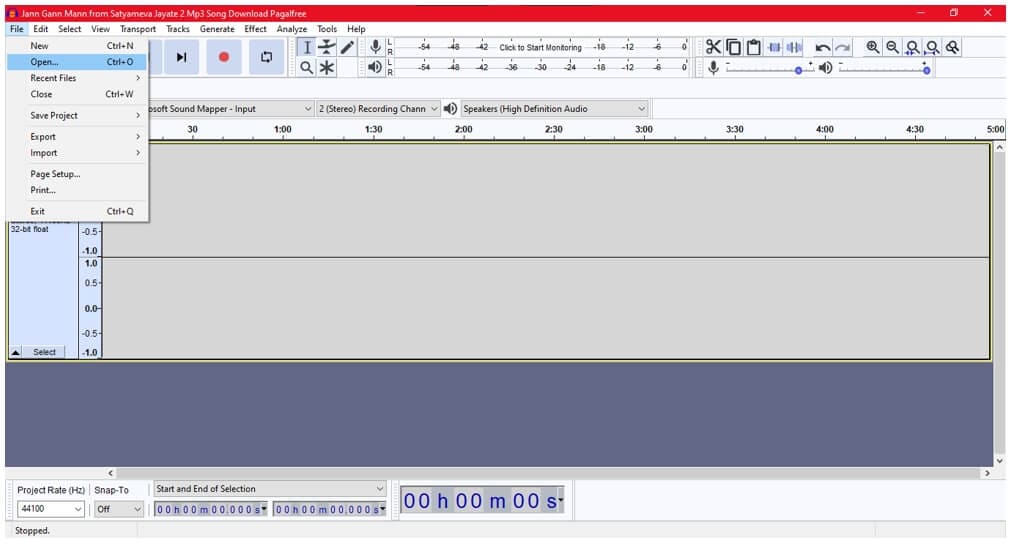
Step 3: Choose the audio track, go to the Effect menu and pick the Amplify option from the drop-down menu.
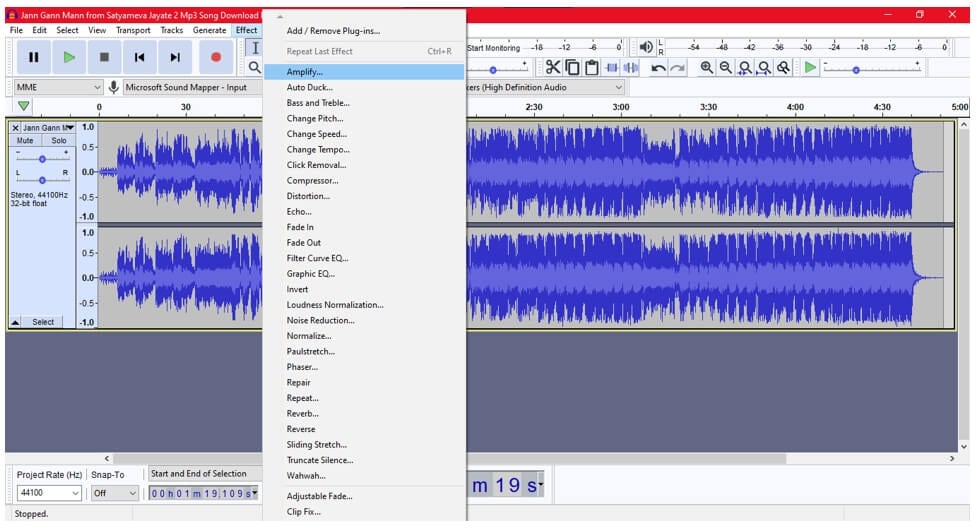
Note: You can increase or decrease the volume by double-clicking the track and using the slider under the Gain title.
Step 4: Increase or decrease the volume by sliding the slider or typing the amplification value in the text box next to it in the Amplify window as needed.
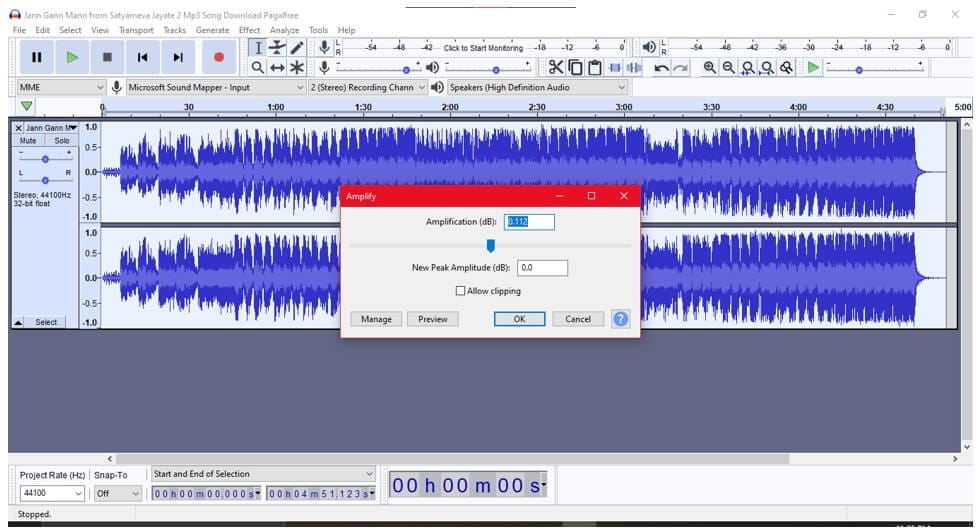
Note: Ensure that the Allow Clipping checkbox remains unchecked to avoid clipping. Moreover, keep in mind that increasing the volume to a greater extent can result in distortion.
Related: How to Change Audio Volume in Filmora
Part 2: How to Increase Volume of Multiple Files in Audacity?
Audacity is an open-source audio editing tool. It is used for various purposes, like audio recording, music creation, and audio file editing. It also allows you to increase and decrease the volume of audio files.
You may also apply the modifications to multiple files at once, rather than one at a time. Check out the instructions below to learn how to change the volume of multiple audio files:
Step 1: Select the Import option from the File menu, and then pick the Audio option. Browse to your audio files, choose all of them, and then click the Open option.
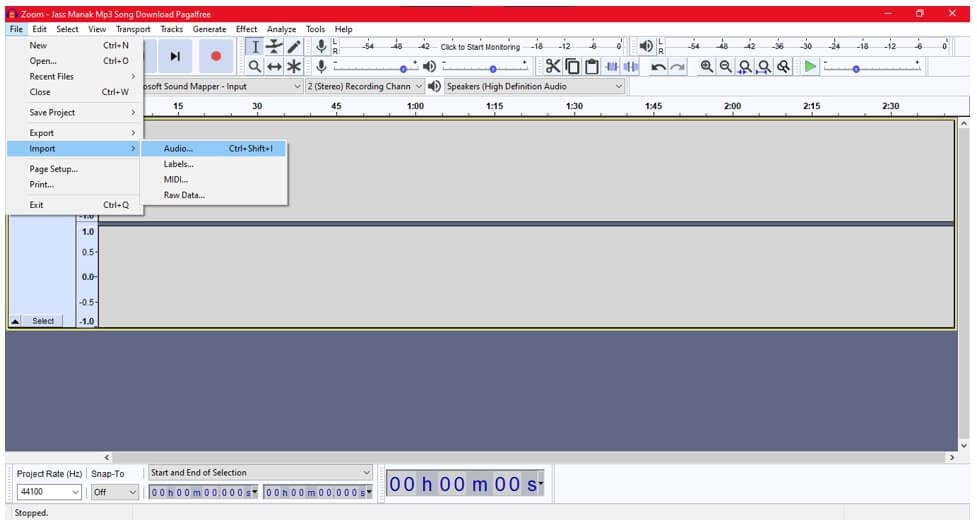
Step 2: To select all the files, press Ctrl + A, click on the Effect option in the menu bar and pick Amplify.

Step 3: Now, either enter the value in the text box next to the Amplification Decibels tab or use the slider under it. To verify the operation of increasing the volume, check the allow clipping checkbox. When you’re through with the options, click the Ok button.
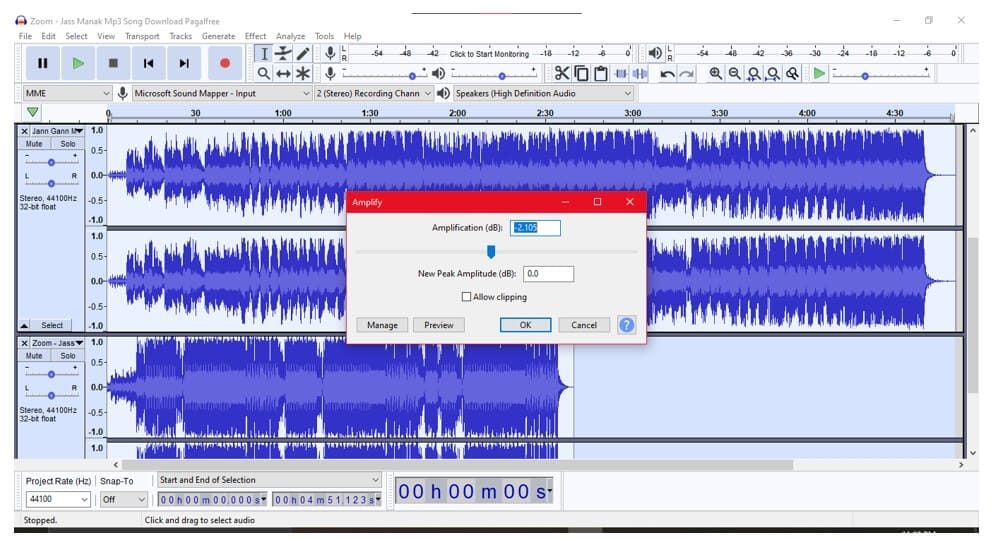
Step 4: Amplification will be applied to all the tracks. Go to the File option from the above menu to export the files and then select the Export option.
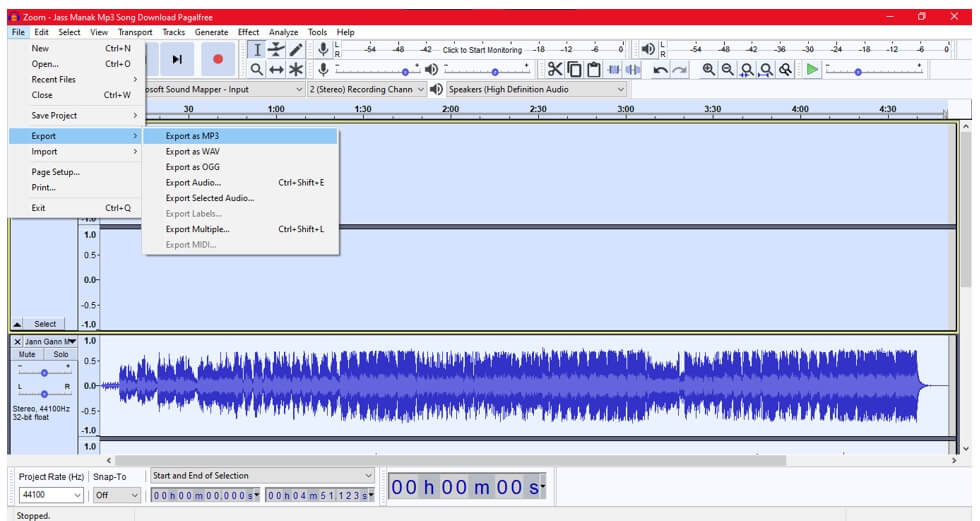
If you’re running Audacity on macOS computer, you can watch the video tutorial below to apply effects to multiple files.
Part 3: How to Increase Volume in Certain Parts of Track?
The audacity software also allows you to alter a specific section of an audio file. The selection tool can assist in locating a particular area of the track. After you’ve chosen a section of the audio file, you may utilize the amplification effect to increase its loudness. Check out the instructions below to learn how you can achieve it:
Step 1: Launch the Audacity software on the computer. To open the audio file, go to the File menu and select Open. You may also open the file by dragging it.
Step 2: Ensure that the Selection tool is active now. Click and hold the mouse left-click to move from one spot on the track to another.
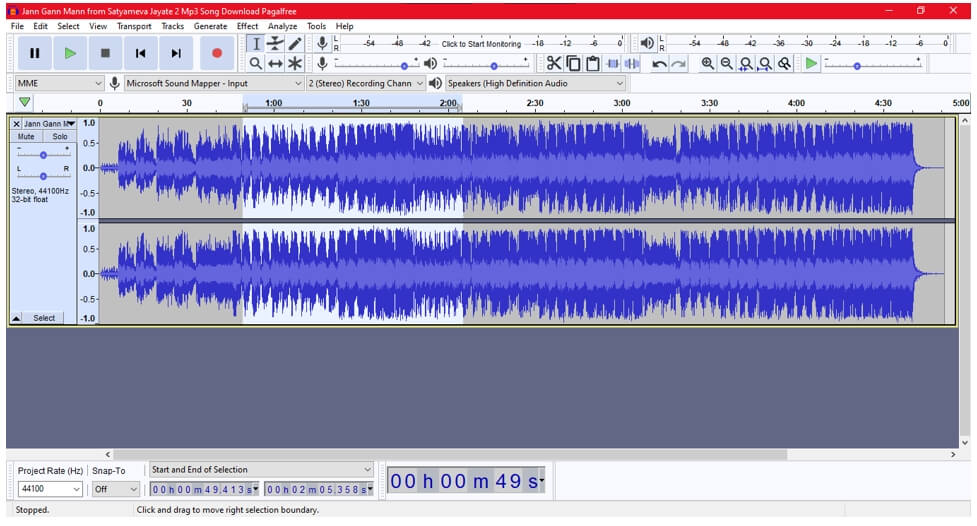
Step 3: After picking the part, go to the Effect option from the menu and select Amplify.
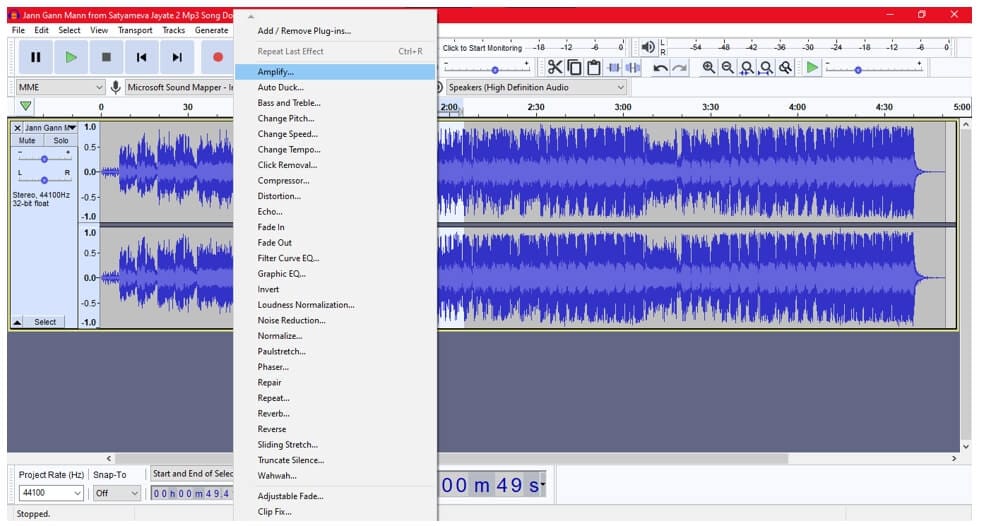
Step 4: Now, for that specific region, modify the amplification and click OK. This will only change the volume for the area you have selected.
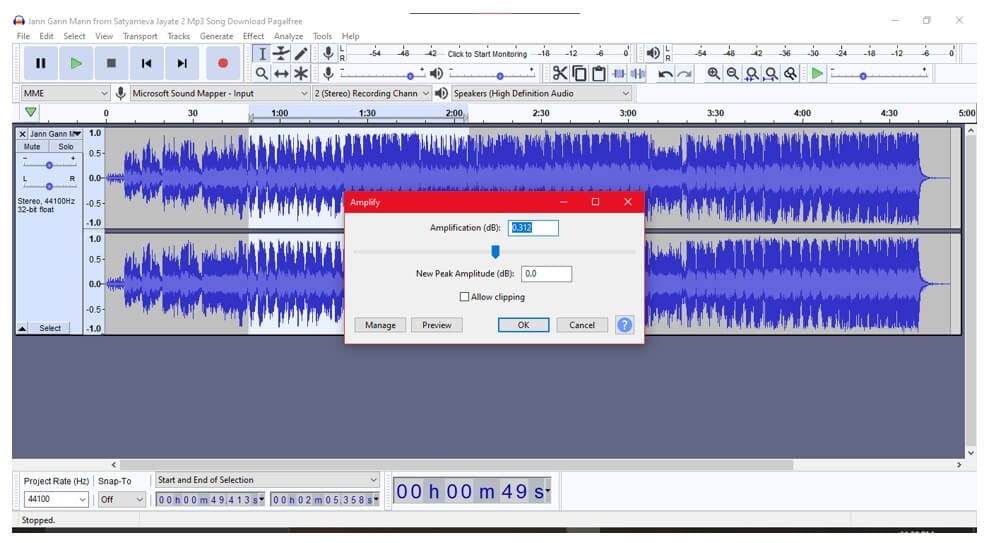
Part 4: What’s the Difference between Normalize and Amplify?
Amplify and Normalize are two essential features of the Audacity tool. Many people think they are the same thing, they are right up to some extent, but there exists a big difference between both the features. Before discussing the differences, you need to know what the terms Normalize and Amplify imply.
Amplify
It is the quickest approach to comprehend the effect’s name if you want to know precisely what impacts are. The frequency of the vibration is enhanced to increase the amplification effect. As previously said, it raises a tiny sound.
Furthermore, because this amplification is extended to all frequencies and amplitude, the noise increases. If you choose ten sources and magnify them by ten decibels, each source will be ten decibels louder than your present sound.
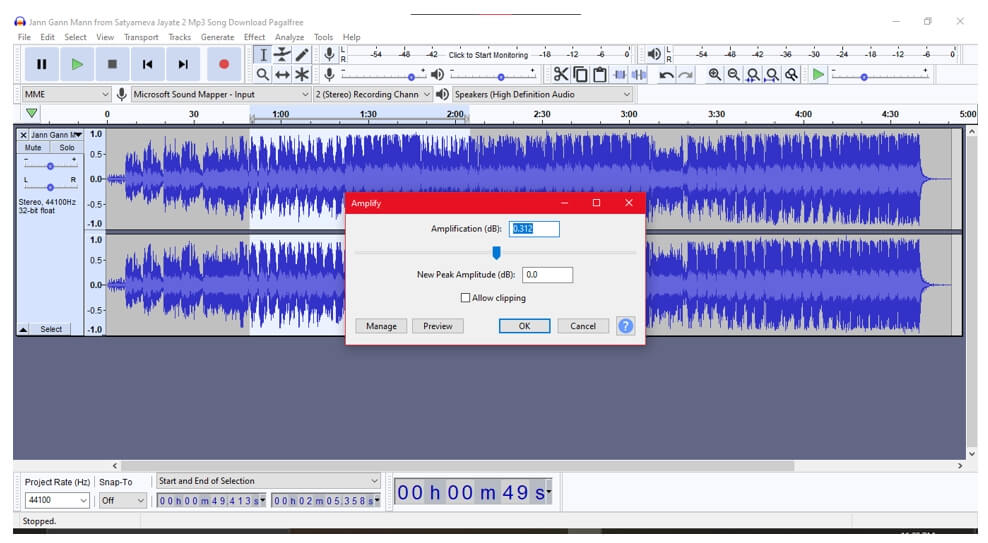
Normalize
The meaning of normalizing is standardized, which is also a feature of its name. Whenever you pick an audio input and use the normalize feature, the level is adjusted automatically according to the previously indicated average volume size in Oda City.
As a result, when one sound source is normalized, there is no discernible difference between it and the amplification mechanism. Still, the effect is evident when several sound sources are performed concurrently.
By pressing Ctrl + A and selecting all ten various audio sources, you may compute the required standard of every sound source, enhance the audio input that is smaller than the normal, and create the audio signal more significant than the standard. Shrink the size of each noise source, such as the name, and normalize the sound.
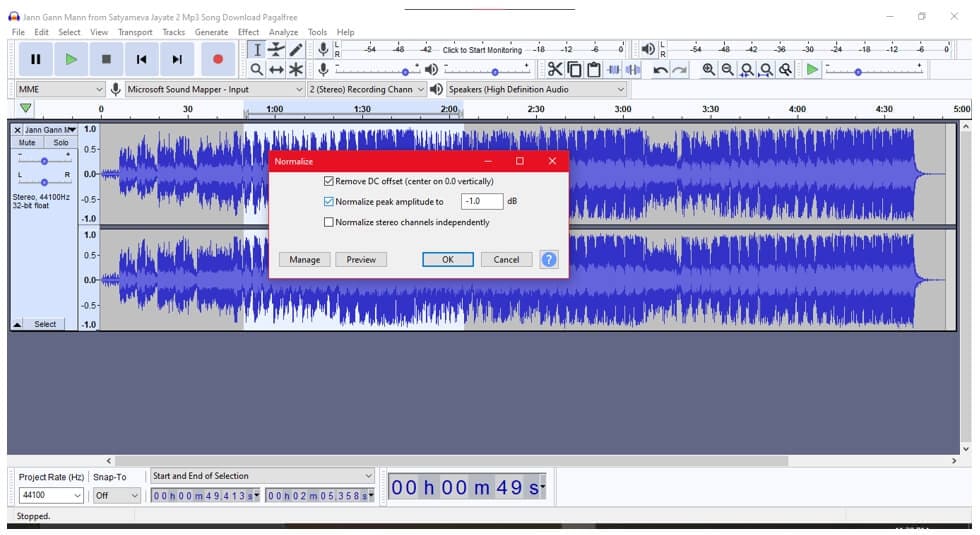
Related: Best Audio Normalizers for Windows
Differences
To differentiate the meaning and impact precisely, amplification means increasing or reducing the sound, whereas normalizing means equalizing the sound. Simply defined, if you magnify ten sources by ten decibels, each of the shorter and louder noises equals ten decibels in their actual loudness.
When the ten sources are normalized, the louder sounds grow louder, conforming to the standard sound source size. Because the amplifying is done regardless, the little noises are going insane during this procedure.
Conclusion
All in all, Audacity does an excellent job at audio editing. If you simply need to modify an audio file, Audacity is a great option. For increasing and decreasing the volume of single and multiple audio files, Audacity is still one of the best bets in the market. We hope that now know how Audacity increase volume of the audio files after reading this article.
02 How to Increase Volume of Multiple Files in Audacity?
03 How to Increase Volume in Certain Parts of Track?
04 What’s the Difference between Normalize and Amplify?
Part 1: How to Increase or Decrease Volume Without Distortion and Clipping in Audacity
Audio clipping occurs when the audio input becomes too loud for an amplifier to produce, and the surplus signal creates distortion. When editing, you cannot add additional volume to your audio clip forever because this would result in clipping. In this case, you can use the Audacity application to emphasize your material by turning the volume up or down without distortion and clipping on a track or recording.
Learn how Audacity increase volume without distortion by following the procedure described below:
Step 1: First, download and install the Audacity software on your computer.
Step 2: Select the File from the menu above and click Open to open the audio file.

Step 3: Choose the audio track, go to the Effect menu and pick the Amplify option from the drop-down menu.

Note: You can increase or decrease the volume by double-clicking the track and using the slider under the Gain title.
Step 4: Increase or decrease the volume by sliding the slider or typing the amplification value in the text box next to it in the Amplify window as needed.

Note: Ensure that the Allow Clipping checkbox remains unchecked to avoid clipping. Moreover, keep in mind that increasing the volume to a greater extent can result in distortion.
Related: How to Change Audio Volume in Filmora
Part 2: How to Increase Volume of Multiple Files in Audacity?
Audacity is an open-source audio editing tool. It is used for various purposes, like audio recording, music creation, and audio file editing. It also allows you to increase and decrease the volume of audio files.
You may also apply the modifications to multiple files at once, rather than one at a time. Check out the instructions below to learn how to change the volume of multiple audio files:
Step 1: Select the Import option from the File menu, and then pick the Audio option. Browse to your audio files, choose all of them, and then click the Open option.

Step 2: To select all the files, press Ctrl + A, click on the Effect option in the menu bar and pick Amplify.

Step 3: Now, either enter the value in the text box next to the Amplification Decibels tab or use the slider under it. To verify the operation of increasing the volume, check the allow clipping checkbox. When you’re through with the options, click the Ok button.

Step 4: Amplification will be applied to all the tracks. Go to the File option from the above menu to export the files and then select the Export option.

If you’re running Audacity on macOS computer, you can watch the video tutorial below to apply effects to multiple files.
Part 3: How to Increase Volume in Certain Parts of Track?
The audacity software also allows you to alter a specific section of an audio file. The selection tool can assist in locating a particular area of the track. After you’ve chosen a section of the audio file, you may utilize the amplification effect to increase its loudness. Check out the instructions below to learn how you can achieve it:
Step 1: Launch the Audacity software on the computer. To open the audio file, go to the File menu and select Open. You may also open the file by dragging it.
Step 2: Ensure that the Selection tool is active now. Click and hold the mouse left-click to move from one spot on the track to another.

Step 3: After picking the part, go to the Effect option from the menu and select Amplify.

Step 4: Now, for that specific region, modify the amplification and click OK. This will only change the volume for the area you have selected.

Part 4: What’s the Difference between Normalize and Amplify?
Amplify and Normalize are two essential features of the Audacity tool. Many people think they are the same thing, they are right up to some extent, but there exists a big difference between both the features. Before discussing the differences, you need to know what the terms Normalize and Amplify imply.
Amplify
It is the quickest approach to comprehend the effect’s name if you want to know precisely what impacts are. The frequency of the vibration is enhanced to increase the amplification effect. As previously said, it raises a tiny sound.
Furthermore, because this amplification is extended to all frequencies and amplitude, the noise increases. If you choose ten sources and magnify them by ten decibels, each source will be ten decibels louder than your present sound.

Normalize
The meaning of normalizing is standardized, which is also a feature of its name. Whenever you pick an audio input and use the normalize feature, the level is adjusted automatically according to the previously indicated average volume size in Oda City.
As a result, when one sound source is normalized, there is no discernible difference between it and the amplification mechanism. Still, the effect is evident when several sound sources are performed concurrently.
By pressing Ctrl + A and selecting all ten various audio sources, you may compute the required standard of every sound source, enhance the audio input that is smaller than the normal, and create the audio signal more significant than the standard. Shrink the size of each noise source, such as the name, and normalize the sound.

Related: Best Audio Normalizers for Windows
Differences
To differentiate the meaning and impact precisely, amplification means increasing or reducing the sound, whereas normalizing means equalizing the sound. Simply defined, if you magnify ten sources by ten decibels, each of the shorter and louder noises equals ten decibels in their actual loudness.
When the ten sources are normalized, the louder sounds grow louder, conforming to the standard sound source size. Because the amplifying is done regardless, the little noises are going insane during this procedure.
Conclusion
All in all, Audacity does an excellent job at audio editing. If you simply need to modify an audio file, Audacity is a great option. For increasing and decreasing the volume of single and multiple audio files, Audacity is still one of the best bets in the market. We hope that now know how Audacity increase volume of the audio files after reading this article.
02 How to Increase Volume of Multiple Files in Audacity?
03 How to Increase Volume in Certain Parts of Track?
04 What’s the Difference between Normalize and Amplify?
Part 1: How to Increase or Decrease Volume Without Distortion and Clipping in Audacity
Audio clipping occurs when the audio input becomes too loud for an amplifier to produce, and the surplus signal creates distortion. When editing, you cannot add additional volume to your audio clip forever because this would result in clipping. In this case, you can use the Audacity application to emphasize your material by turning the volume up or down without distortion and clipping on a track or recording.
Learn how Audacity increase volume without distortion by following the procedure described below:
Step 1: First, download and install the Audacity software on your computer.
Step 2: Select the File from the menu above and click Open to open the audio file.

Step 3: Choose the audio track, go to the Effect menu and pick the Amplify option from the drop-down menu.

Note: You can increase or decrease the volume by double-clicking the track and using the slider under the Gain title.
Step 4: Increase or decrease the volume by sliding the slider or typing the amplification value in the text box next to it in the Amplify window as needed.

Note: Ensure that the Allow Clipping checkbox remains unchecked to avoid clipping. Moreover, keep in mind that increasing the volume to a greater extent can result in distortion.
Related: How to Change Audio Volume in Filmora
Part 2: How to Increase Volume of Multiple Files in Audacity?
Audacity is an open-source audio editing tool. It is used for various purposes, like audio recording, music creation, and audio file editing. It also allows you to increase and decrease the volume of audio files.
You may also apply the modifications to multiple files at once, rather than one at a time. Check out the instructions below to learn how to change the volume of multiple audio files:
Step 1: Select the Import option from the File menu, and then pick the Audio option. Browse to your audio files, choose all of them, and then click the Open option.

Step 2: To select all the files, press Ctrl + A, click on the Effect option in the menu bar and pick Amplify.

Step 3: Now, either enter the value in the text box next to the Amplification Decibels tab or use the slider under it. To verify the operation of increasing the volume, check the allow clipping checkbox. When you’re through with the options, click the Ok button.

Step 4: Amplification will be applied to all the tracks. Go to the File option from the above menu to export the files and then select the Export option.

If you’re running Audacity on macOS computer, you can watch the video tutorial below to apply effects to multiple files.
Part 3: How to Increase Volume in Certain Parts of Track?
The audacity software also allows you to alter a specific section of an audio file. The selection tool can assist in locating a particular area of the track. After you’ve chosen a section of the audio file, you may utilize the amplification effect to increase its loudness. Check out the instructions below to learn how you can achieve it:
Step 1: Launch the Audacity software on the computer. To open the audio file, go to the File menu and select Open. You may also open the file by dragging it.
Step 2: Ensure that the Selection tool is active now. Click and hold the mouse left-click to move from one spot on the track to another.

Step 3: After picking the part, go to the Effect option from the menu and select Amplify.

Step 4: Now, for that specific region, modify the amplification and click OK. This will only change the volume for the area you have selected.

Part 4: What’s the Difference between Normalize and Amplify?
Amplify and Normalize are two essential features of the Audacity tool. Many people think they are the same thing, they are right up to some extent, but there exists a big difference between both the features. Before discussing the differences, you need to know what the terms Normalize and Amplify imply.
Amplify
It is the quickest approach to comprehend the effect’s name if you want to know precisely what impacts are. The frequency of the vibration is enhanced to increase the amplification effect. As previously said, it raises a tiny sound.
Furthermore, because this amplification is extended to all frequencies and amplitude, the noise increases. If you choose ten sources and magnify them by ten decibels, each source will be ten decibels louder than your present sound.

Normalize
The meaning of normalizing is standardized, which is also a feature of its name. Whenever you pick an audio input and use the normalize feature, the level is adjusted automatically according to the previously indicated average volume size in Oda City.
As a result, when one sound source is normalized, there is no discernible difference between it and the amplification mechanism. Still, the effect is evident when several sound sources are performed concurrently.
By pressing Ctrl + A and selecting all ten various audio sources, you may compute the required standard of every sound source, enhance the audio input that is smaller than the normal, and create the audio signal more significant than the standard. Shrink the size of each noise source, such as the name, and normalize the sound.

Related: Best Audio Normalizers for Windows
Differences
To differentiate the meaning and impact precisely, amplification means increasing or reducing the sound, whereas normalizing means equalizing the sound. Simply defined, if you magnify ten sources by ten decibels, each of the shorter and louder noises equals ten decibels in their actual loudness.
When the ten sources are normalized, the louder sounds grow louder, conforming to the standard sound source size. Because the amplifying is done regardless, the little noises are going insane during this procedure.
Conclusion
All in all, Audacity does an excellent job at audio editing. If you simply need to modify an audio file, Audacity is a great option. For increasing and decreasing the volume of single and multiple audio files, Audacity is still one of the best bets in the market. We hope that now know how Audacity increase volume of the audio files after reading this article.
02 How to Increase Volume of Multiple Files in Audacity?
03 How to Increase Volume in Certain Parts of Track?
04 What’s the Difference between Normalize and Amplify?
Part 1: How to Increase or Decrease Volume Without Distortion and Clipping in Audacity
Audio clipping occurs when the audio input becomes too loud for an amplifier to produce, and the surplus signal creates distortion. When editing, you cannot add additional volume to your audio clip forever because this would result in clipping. In this case, you can use the Audacity application to emphasize your material by turning the volume up or down without distortion and clipping on a track or recording.
Learn how Audacity increase volume without distortion by following the procedure described below:
Step 1: First, download and install the Audacity software on your computer.
Step 2: Select the File from the menu above and click Open to open the audio file.

Step 3: Choose the audio track, go to the Effect menu and pick the Amplify option from the drop-down menu.

Note: You can increase or decrease the volume by double-clicking the track and using the slider under the Gain title.
Step 4: Increase or decrease the volume by sliding the slider or typing the amplification value in the text box next to it in the Amplify window as needed.

Note: Ensure that the Allow Clipping checkbox remains unchecked to avoid clipping. Moreover, keep in mind that increasing the volume to a greater extent can result in distortion.
Related: How to Change Audio Volume in Filmora
Part 2: How to Increase Volume of Multiple Files in Audacity?
Audacity is an open-source audio editing tool. It is used for various purposes, like audio recording, music creation, and audio file editing. It also allows you to increase and decrease the volume of audio files.
You may also apply the modifications to multiple files at once, rather than one at a time. Check out the instructions below to learn how to change the volume of multiple audio files:
Step 1: Select the Import option from the File menu, and then pick the Audio option. Browse to your audio files, choose all of them, and then click the Open option.

Step 2: To select all the files, press Ctrl + A, click on the Effect option in the menu bar and pick Amplify.

Step 3: Now, either enter the value in the text box next to the Amplification Decibels tab or use the slider under it. To verify the operation of increasing the volume, check the allow clipping checkbox. When you’re through with the options, click the Ok button.

Step 4: Amplification will be applied to all the tracks. Go to the File option from the above menu to export the files and then select the Export option.

If you’re running Audacity on macOS computer, you can watch the video tutorial below to apply effects to multiple files.
Part 3: How to Increase Volume in Certain Parts of Track?
The audacity software also allows you to alter a specific section of an audio file. The selection tool can assist in locating a particular area of the track. After you’ve chosen a section of the audio file, you may utilize the amplification effect to increase its loudness. Check out the instructions below to learn how you can achieve it:
Step 1: Launch the Audacity software on the computer. To open the audio file, go to the File menu and select Open. You may also open the file by dragging it.
Step 2: Ensure that the Selection tool is active now. Click and hold the mouse left-click to move from one spot on the track to another.

Step 3: After picking the part, go to the Effect option from the menu and select Amplify.

Step 4: Now, for that specific region, modify the amplification and click OK. This will only change the volume for the area you have selected.

Part 4: What’s the Difference between Normalize and Amplify?
Amplify and Normalize are two essential features of the Audacity tool. Many people think they are the same thing, they are right up to some extent, but there exists a big difference between both the features. Before discussing the differences, you need to know what the terms Normalize and Amplify imply.
Amplify
It is the quickest approach to comprehend the effect’s name if you want to know precisely what impacts are. The frequency of the vibration is enhanced to increase the amplification effect. As previously said, it raises a tiny sound.
Furthermore, because this amplification is extended to all frequencies and amplitude, the noise increases. If you choose ten sources and magnify them by ten decibels, each source will be ten decibels louder than your present sound.

Normalize
The meaning of normalizing is standardized, which is also a feature of its name. Whenever you pick an audio input and use the normalize feature, the level is adjusted automatically according to the previously indicated average volume size in Oda City.
As a result, when one sound source is normalized, there is no discernible difference between it and the amplification mechanism. Still, the effect is evident when several sound sources are performed concurrently.
By pressing Ctrl + A and selecting all ten various audio sources, you may compute the required standard of every sound source, enhance the audio input that is smaller than the normal, and create the audio signal more significant than the standard. Shrink the size of each noise source, such as the name, and normalize the sound.

Related: Best Audio Normalizers for Windows
Differences
To differentiate the meaning and impact precisely, amplification means increasing or reducing the sound, whereas normalizing means equalizing the sound. Simply defined, if you magnify ten sources by ten decibels, each of the shorter and louder noises equals ten decibels in their actual loudness.
When the ten sources are normalized, the louder sounds grow louder, conforming to the standard sound source size. Because the amplifying is done regardless, the little noises are going insane during this procedure.
Conclusion
All in all, Audacity does an excellent job at audio editing. If you simply need to modify an audio file, Audacity is a great option. For increasing and decreasing the volume of single and multiple audio files, Audacity is still one of the best bets in the market. We hope that now know how Audacity increase volume of the audio files after reading this article.
“Essential Audio Setups for Personalized Mobile Soundscapes”
Cut mp3, cut ringtone application help you cut a favorite part of an audio song, a music file. You can use the cut result as ringtone, alarm, notification tone or a music song. You can manage cut results easily and you can share them with your friends.
This app is a best choice to make your own ringtones (support WAV, FLAC, AAC formats). User can record a live audio then use this app as editor to edit and trim the best parts.
editor supports MP3, WAV, AAC, AMR, FLAC and most other music formats. Music editor, alarm tone maker, ringtone cutter or notification tone creator are other names of this application.
1. MP3 CUTTER AND RINGTONE MAKER
Professional audio editor. MP3 Cutter & Ringtone Maker enables you to select audio length quickly with waveform zooming or one tap to set start time or end time manually. And you can trim music and re-edit music clips inside the audio editor. ♪ Efficient audio trimmer.
STEPS ON HOW TO USE MP3 CUTTER AND RINGTONE MAKER
You can quickly create a ringtone with this powerful Ringtone maker app within a few simple steps:-
Step 1:- Install this amazing ringtone maker app by searching Mp3 Cutter & Video Cutter App on the play store.
Step 2:- After installation. Click on the Audio Cutter icon
Step 3:- Now select your favorite song that you want to use as your Ringtone.
Step 4:- Select the part that you want to save as a ringtone & click on the save button.
Step 5:- Now that you have successfully created your Audio. You can choose it as your ringtone by selecting the (Set as a ringtone) option from your system audio player.
2. INSHOT RINGTONE MAKER
InShot MP3 Cutter and Ringtone Maker is a ringtone maker app that lets us customize an Android smartphone or tablet. From its main menu, we will be able to access different tones and audios to use at will after watching an advertisement or switching to pro mode.
InShot Ringtone maker is at the top of the interface. Here, a series of audio editing tools are displayed that offers us the possibility to edit all the sound files that we have stored on our Android device.
Also, this app supports lots of audio file types, such as MP3, WAV, FLAC, or M4A. On the other hand, we can also convert the formats, adjust the bit rate of each audio, change the volume, edit the audio file tags, and in general, customize each ringtone. And the APK file download is free of charge.
3. FREE MP3 CUTTER - RINGTONE MAKER
With MP3 Cutter & Ringtone Maker, you can easily trim music, merge music, mix music and accurately cut out the tuneful part of music and set it as a unique ringtone for every contact. Customizing your own alarm/notification is also viable. It even supports bitrate & volume adjustment to create the highest quality melody for you.
All you have to do to create a ringtone is select the song you want to use, and then mark out the range of the song you want to be played. All this can take be done with just a few taps on the screen. Once you have finished working with a song, you can save the results on your terminal, for use as an alarm, ringtone, etc.
MP3 Cutter and Ringtone Maker is an easy to use tool that can be used to create some really fun ringtones. Among other things, you can record and cut out fragments of conversations with your friends, or use audio from any film or video.
4. RINGTONE MAKER FOR IOS
A completely free ringtone production software. Without connection to the computer, the ringtone can be produced via iPhone. Set the song collected by you as ringtone.
The APP size is only about 20Mb after optimization (slight difference between different models). Your iPhone ringtone can be produced quickly after quick downloading. Based on the latest production method, the ringtone production can be completed within several seconds.
Each iPhone user can successfully produce the ringtone. In case of any problem arising in the process of producing the ringtone, directly contact us as per the contact way in the app to get one-to-one help free of charge.
CONCLUSION
Admittedly, there are countless other apps in the store that can do the job of changing your iPhone/Android ringtones. But not every app deserves your time or attention. However, creating custom ringtones still involves some steps. So, if you’re not sure about how to make a ringtone on iPhone Android yet, don’t worry. The above guides can provide you with baby steps to help you navigate through.
Transforming Podcast Content Into High-Quality MP3 Audio: A Step-by-Step Guide
Converting podcasts to MP3 is simpler than many of you think. Whether you’re looking to convert a podcast to MP3 to make it available for playing on your mobile device or share it with a friend, there are various ways to get the job done within a few clicks.
To help you out, we’ve explored different reliable methods that can come in handy to convert podcasts to MP3 without requiring technical knowledge. Keep reading to find out more!
Part 1. Can You Convert Podcast to mp3?
Yes, of course. Podcasts can be converted to MP3 by using either your podcast player, an online audio conversion tool, audio converter software, or iTunes.
Part 2. Why Should You Convert Podcast to mp3?
The main reason why you might need to convert podcasts to MP3 is that MP3 is a widely accepted format. Although some podcast player supports WAV formats, it’s advisable to keep your podcast file in MP3 so you won’t be castigated over your podcast’s audio format by listeners.
Part 3. How To Convert Podcast to mp3?
As mentioned earlier, you can convert podcasts to MP3 directly from a podcast player, using an online converter, or with iTunes.
Regardless of what method you choose to use, we’ve explained the simple steps to help you operate smoothly. Keep reading!
Way 1: Convert podcast to mp3 directly by podcast payers - Spotify
Some podcast apps like Spotify, Google Podcast, Apple Podcast, and many others allow users to directly download their favorite podcast episodes in MP3 format for offline listening. So, if you’re looking to convert podcast to MP3 without using an online or third-party tool, you can easily download it from the podcast app you’re using.
We’ve outlined the steps to convert a podcast to MP3 directly from a podcast player like Spotify podcast player below;
For Android & iOS
Step1 Open the Spotify app on your smartphone and locate the Podcast you want to convert to MP3. Then, tap on See All Episodes.
Step2 Tap the Download icon next to the podcast to save it as MP3 to your device.

Step3 To find the downloaded podcast, go to Your Library > Podcasts. Then, select Downloads to see the podcast files.
For Computer
The process of converting podcasts to MP3 on Spotify via computer is similar to using a mobile device. You just need to do the following;
Step1 Open the Spotify app and login into your account.
Step2 Locate the Podcast that you wish to convert to MP3.
Step3 Move your cursor over the podcast episode you want to convert. Then, click the Download icon next to it to convert it to MP3.

![]()
Note: You must have a premium Spotify account to be able to download podcasts.
Way 2: Convert podcasts to mp3 by online converters or converting software
If the Podcast you’re looking to convert to MP3 is not on a podcast manager, don’t panic. Tech experts have innovated various online tools that can also be used to convert podcasts to MP3s. So, if the Podcast you want to convert to MP3 is saved as a file on your device, you can employ a reliable online converter to execute the operation without compromising the quality of the Podcast.
We’ve curated a list of some online converters you can use below;
1. Convert Podcasts to MP3 with Uniconverter
Wondershare Uniconverter is a video/audio conversion tool that allows the conversion of files in various formats to another format without compromising the file’s quality. The tool is used by professionals to convert podcasts to MP3, as it boasts fast conversion speed and has a clean interface that makes it very easy to use.
Here is how to use Uniconverter to convert podcasts to MP3;
Step1 Install the Uniconverter software on your PC or macOS.
Step2 Click the Convert function from the top-left side. Then, use the Add Fies button at the top left corner of the screen to upload the podcast file that you’re looking to convert.
![]()
Step3 Click the drop-down icon next to Output Format. Then, select Audio > MP3 and choose the quality you want the output file to be.
![]()
Step4 Click File Location from the bottom left corner and select the path where you want the output file to be saved. Then, click Convert to start converting the podcast to MP3. This will take only a few minutes to complete.
![]()
Pros
- Convert unlimited podcasts to MP3 for free.
- Fast conversion speed.
- Supports batch conversion.
- It’s safe.
Cons
- It requires installation.
- You need to upgrade to premium to access all its features.
2. Convert Podcasts to MP3 Online with Media.io
The above method requires you to install a third-party app. But if you prefer using an online podcast converter, then Media.io is one of the best choices that’s worth trying. The tool allows you to quickly convert audio files into various formats safely and securely online.
Follow the following steps to use Media.io to convert your podcast;
Step1 Open theMedia.io Online Audio Converter tool on your browser and click Choose Files to upload the podcast file(s) you’re looking to convert. You can also upload the file from Google Drive, Dropbox, or via YouTube URL.

Step2 Click the drop-down icon next to To and select Audio. Then, choose MP3 as the preferred output format and click Convert to begin the conversion process.
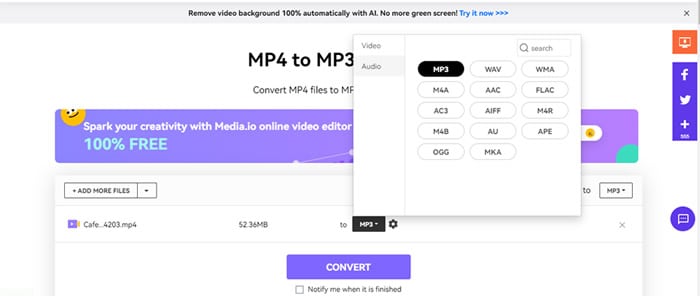
Step3 Once the file has been successfully converted to MP3, click the Download button to save it to your device’s local storage.
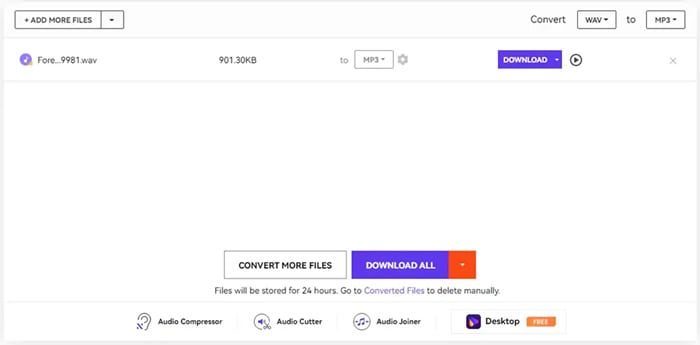
Pros
- It’s easy to operate.
- It’s safe and secure.
- No watermark.
- Fast conversion speed.
Cons
- It uploads files slowly.
3. Convert Podcast to MP3 With Online-Convert
If Media.io does not have what it takes to suit your requirements, Online-Convert is another excellent tool that can help you convert audio files from one format to another. Though it’s not 100% free like Media.io.
Here is how to use Online-Convert to convert podcast to MP3 online;
Step1 Open Online Convert online Audio to MP3 converter in your browser and click Choose File to upload the podcast file that you want to convert.

Step2 Click Start to begin the conversion.

Step3 Finally, click Download to save the converted file to your storage.

Pros
- Convert podcasts to MP3 without installing a third-party app.
- It’s easy to use.
- Supports simultaneous conversion of multiple podcast files.
Cons
- You must upgrade your account to be able to convert unlimited podcast files to MP3.
Way 3: Convert podcast to mp3 via iTunes
Besides music streaming, Apple iTunes also allows the conversion of audio files from one format to another. So, if you’ve got iTunes installed on your PC or Mac, you can easily employ it to convert the podcast to MP3. But this might not be a reliable option if you looking to convert many podcast episodes to MP3.
See the steps to convert podcast to MP3 with iTunes;
Step1 Open the iTunes app on your computer and click File from the top-left. Then, select Add File to Library to upload the podcast that you’re looking to convert.
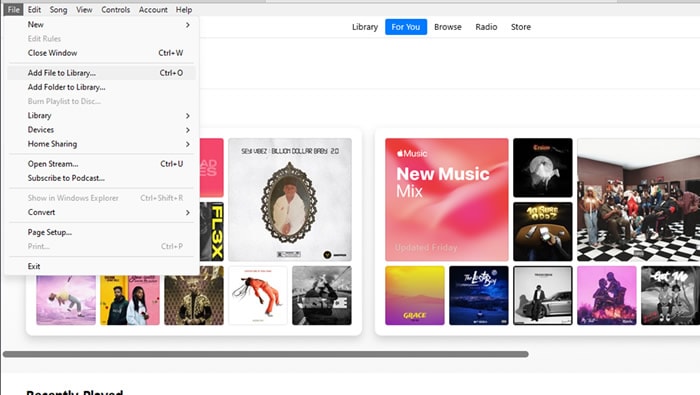
Step2 Once you upload the podcast, click Edit from the top bar. Then, select Preferences.
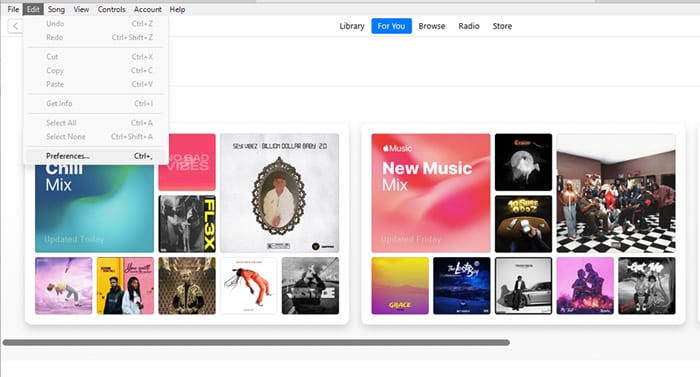
Step3 Click the General tab and select Import Settings.
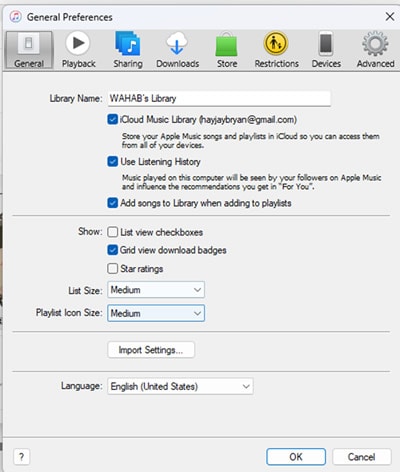
- Click the drop-down icon next to Import Using and select MP3 Encoder. Then, click OK.
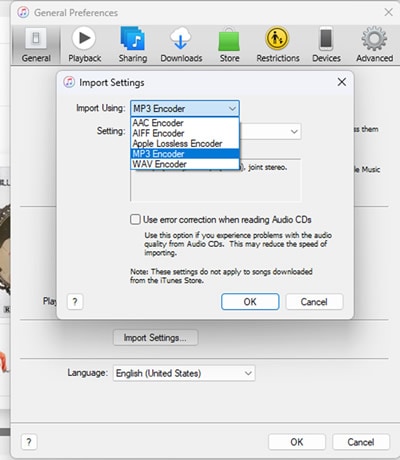
Step4 Click File from the top-left side once again. Then, select Convert > Create MP3 version.
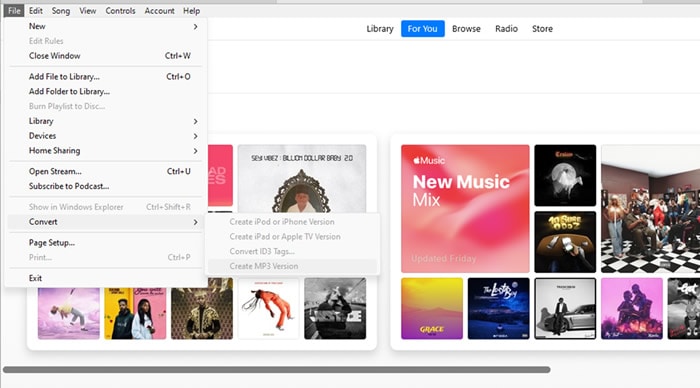
You’ve successfully converted the podcast to MP3!
Pros & Cons of using iTunes to Convert Podcasts to MP3
Pros
- It’s free.
- It’s easy to use.
- It does not reduce podcast quality.
Cons
- It’s not efficient for converting many podcast files.
Part 4. Tips & Tricks for Podcast to MP3 Conversion
- Convert Multiple Podcast Files Simultaneously: If you have a bunch of podcasts to convert to MP3, it’s advisable to use online tools or software like the ones mentioned in the article above to convert all of them at once. It saves you from unwanted stress and wasting your time.
- Add Podcasts to “My Favorites” or “Save to My Library: Add all podcasts you wish to convert to “My Favorites” or save them to your library so you can easily locate them.
- Ensure to have a stable internet connection when using an online tool: Make sure you have a stable internet connection when using online audio converters to convert podcasts to MP3. It makes the process smooth and straightforward.
Final Words
The above techniques are efficient for converting podcasts to MP3. As you can see, it does not matter whether you’re looking to use a podcast manager app like Spotify, online converter, software, or iTunes, the steps are very easy to employ.
Overall, make sure you read the pros and cons attached to using each method so you can choose the one that suits your requirements.
Way 2: Convert podcasts to mp3 by online converters or converting software
If the Podcast you’re looking to convert to MP3 is not on a podcast manager, don’t panic. Tech experts have innovated various online tools that can also be used to convert podcasts to MP3s. So, if the Podcast you want to convert to MP3 is saved as a file on your device, you can employ a reliable online converter to execute the operation without compromising the quality of the Podcast.
We’ve curated a list of some online converters you can use below;
1. Convert Podcasts to MP3 with Uniconverter
Wondershare Uniconverter is a video/audio conversion tool that allows the conversion of files in various formats to another format without compromising the file’s quality. The tool is used by professionals to convert podcasts to MP3, as it boasts fast conversion speed and has a clean interface that makes it very easy to use.
Here is how to use Uniconverter to convert podcasts to MP3;
Step1 Install the Uniconverter software on your PC or macOS.
Step2 Click the Convert function from the top-left side. Then, use the Add Fies button at the top left corner of the screen to upload the podcast file that you’re looking to convert.
![]()
Step3 Click the drop-down icon next to Output Format. Then, select Audio > MP3 and choose the quality you want the output file to be.
![]()
Step4 Click File Location from the bottom left corner and select the path where you want the output file to be saved. Then, click Convert to start converting the podcast to MP3. This will take only a few minutes to complete.
![]()
Pros
- Convert unlimited podcasts to MP3 for free.
- Fast conversion speed.
- Supports batch conversion.
- It’s safe.
Cons
- It requires installation.
- You need to upgrade to premium to access all its features.
2. Convert Podcasts to MP3 Online with Media.io
The above method requires you to install a third-party app. But if you prefer using an online podcast converter, then Media.io is one of the best choices that’s worth trying. The tool allows you to quickly convert audio files into various formats safely and securely online.
Follow the following steps to use Media.io to convert your podcast;
Step1 Open theMedia.io Online Audio Converter tool on your browser and click Choose Files to upload the podcast file(s) you’re looking to convert. You can also upload the file from Google Drive, Dropbox, or via YouTube URL.

Step2 Click the drop-down icon next to To and select Audio. Then, choose MP3 as the preferred output format and click Convert to begin the conversion process.

Step3 Once the file has been successfully converted to MP3, click the Download button to save it to your device’s local storage.

Pros
- It’s easy to operate.
- It’s safe and secure.
- No watermark.
- Fast conversion speed.
Cons
- It uploads files slowly.
3. Convert Podcast to MP3 With Online-Convert
If Media.io does not have what it takes to suit your requirements, Online-Convert is another excellent tool that can help you convert audio files from one format to another. Though it’s not 100% free like Media.io.
Here is how to use Online-Convert to convert podcast to MP3 online;
Step1 Open Online Convert online Audio to MP3 converter in your browser and click Choose File to upload the podcast file that you want to convert.

Step2 Click Start to begin the conversion.

Step3 Finally, click Download to save the converted file to your storage.

Pros
- Convert podcasts to MP3 without installing a third-party app.
- It’s easy to use.
- Supports simultaneous conversion of multiple podcast files.
Cons
- You must upgrade your account to be able to convert unlimited podcast files to MP3.
Way 3: Convert podcast to mp3 via iTunes
Besides music streaming, Apple iTunes also allows the conversion of audio files from one format to another. So, if you’ve got iTunes installed on your PC or Mac, you can easily employ it to convert the podcast to MP3. But this might not be a reliable option if you looking to convert many podcast episodes to MP3.
See the steps to convert podcast to MP3 with iTunes;
Step1 Open the iTunes app on your computer and click File from the top-left. Then, select Add File to Library to upload the podcast that you’re looking to convert.

Step2 Once you upload the podcast, click Edit from the top bar. Then, select Preferences.

Step3 Click the General tab and select Import Settings.

- Click the drop-down icon next to Import Using and select MP3 Encoder. Then, click OK.

Step4 Click File from the top-left side once again. Then, select Convert > Create MP3 version.

You’ve successfully converted the podcast to MP3!
Pros & Cons of using iTunes to Convert Podcasts to MP3
Pros
- It’s free.
- It’s easy to use.
- It does not reduce podcast quality.
Cons
- It’s not efficient for converting many podcast files.
Part 4. Tips & Tricks for Podcast to MP3 Conversion
- Convert Multiple Podcast Files Simultaneously: If you have a bunch of podcasts to convert to MP3, it’s advisable to use online tools or software like the ones mentioned in the article above to convert all of them at once. It saves you from unwanted stress and wasting your time.
- Add Podcasts to “My Favorites” or “Save to My Library: Add all podcasts you wish to convert to “My Favorites” or save them to your library so you can easily locate them.
- Ensure to have a stable internet connection when using an online tool: Make sure you have a stable internet connection when using online audio converters to convert podcasts to MP3. It makes the process smooth and straightforward.
Final Words
The above techniques are efficient for converting podcasts to MP3. As you can see, it does not matter whether you’re looking to use a podcast manager app like Spotify, online converter, software, or iTunes, the steps are very easy to employ.
Overall, make sure you read the pros and cons attached to using each method so you can choose the one that suits your requirements.
Also read:
- [New] Capturing Sounds Audacity Tutorial for Mac Users
- 2024 Approved Instagram TV Essentials Step-by-Step Upload Guide
- Beginner's Guide: Top 10 Swift Strategies for Mastering New X
- Economical Texting Hacks: Minimizing Data Usage While Messaging
- In 2024, How to Change GPS Location on Infinix Note 30 VIP Racing Edition Easily & Safely | Dr.fone
- In 2024, Pixel Perfection Portfolio Best Animation Transformation Tools
- Tips of Playing M4A Audio Files on Android Devices
- Unlocking Speech From Melody Top 3 Online Methods for MP3-to-Text Conversion
- Updated Crafting Soundscapes with Online Echoes Integrating Digital Reverb S Audio Mixing for 2024
- Updated In 2024, 10 Prime Pages to Acquire Digital Ding Tone Files with Hassle-Free Downloads
- Updated In 2024, Best Video Editing Software to Remove Audio From Video For Windows
- Title: Adjusting Sound Levels in Audacity Raising the Volume Up, Lowering It Down for 2024
- Author: Jacob
- Created at : 2024-10-23 20:25:00
- Updated at : 2024-10-29 16:01:16
- Link: https://audio-shaping.techidaily.com/adjusting-sound-levels-in-audacity-raising-the-volume-up-lowering-it-down-for-2024/
- License: This work is licensed under CC BY-NC-SA 4.0.